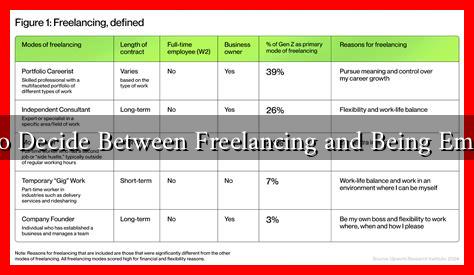-
Table of Contents
- How to Decide Between Freelancing and Being Employed
- Understanding Freelancing
- Advantages of Freelancing
- Challenges of Freelancing
- Understanding Traditional Employment
- Advantages of Traditional Employment
- Challenges of Traditional Employment
- Key Considerations for Your Decision
- Your Financial Situation
- Your Career Goals
- Your Work Style
- Real-World Examples
- Conclusion
How to Decide Between Freelancing and Being Employed
In today’s dynamic job market, professionals often find themselves at a crossroads: should they pursue freelancing or seek traditional employment? Both paths offer unique advantages and challenges, making the decision a complex one. This article aims to provide a comprehensive guide to help you weigh your options and make an informed choice.
Understanding Freelancing
Freelancing refers to working independently, often on a project basis, for various clients. This model has gained popularity due to the rise of the gig economy and advancements in technology that facilitate remote work.
Advantages of Freelancing
- Flexibility: Freelancers can set their own schedules, allowing for a better work-life balance.
- Diverse Opportunities: Freelancers can work on a variety of projects across different industries, enhancing their skills and portfolio.
- Potential for Higher Earnings: Successful freelancers can often charge higher rates than their salaried counterparts.
Challenges of Freelancing
- Income Instability: Freelancers may experience fluctuations in income, making financial planning more challenging.
- Self-Employment Taxes: Freelancers are responsible for their own taxes, which can be more complicated than traditional employment tax structures.
- Isolation: Working independently can lead to feelings of loneliness and disconnection from a team.
Understanding Traditional Employment
Traditional employment typically involves working for a single employer on a full-time or part-time basis, often with a structured salary and benefits.
Advantages of Traditional Employment
- Stable Income: Employees receive a consistent paycheck, making budgeting and financial planning easier.
- Benefits: Many employers offer health insurance, retirement plans, and paid time off, which can enhance overall job satisfaction.
- Career Development: Employees often have access to training programs and opportunities for advancement within the company.
Challenges of Traditional Employment
- Less Flexibility: Employees typically have set hours and may have less control over their work environment.
- Limited Variety: Working for one employer may lead to a narrower range of experiences and skills.
- Office Politics: Navigating workplace dynamics can be challenging and may affect job satisfaction.
Key Considerations for Your Decision
When deciding between freelancing and traditional employment, consider the following factors:
Your Financial Situation
Evaluate your current financial stability. If you have savings to fall back on, freelancing may be a viable option. However, if you need a steady income to meet your financial obligations, traditional employment might be the better choice.
Your Career Goals
Consider your long-term career aspirations. If you aim to build a diverse skill set and enjoy varied work, freelancing could be more fulfilling. Conversely, if you seek stability and a clear career path, traditional employment may align better with your goals.
Your Work Style
Reflect on your preferred work style. Are you self-motivated and comfortable working alone? Freelancing might suit you. If you thrive in collaborative environments and enjoy team dynamics, traditional employment could be more appealing.
Real-World Examples
Many professionals have successfully navigated the decision between freelancing and traditional employment. For instance, Jane, a graphic designer, started as a freelancer and built a robust client base. However, she eventually transitioned to a full-time role at a marketing agency, where she found stability and opportunities for growth. On the other hand, Mark, a software developer, chose freelancing to enjoy the flexibility of working from anywhere, allowing him to travel while maintaining his career.
Conclusion
Deciding between freelancing and traditional employment is a personal choice that depends on various factors, including financial stability, career goals, and work style. By carefully considering the advantages and challenges of each option, you can make an informed decision that aligns with your aspirations. Whether you choose the independence of freelancing or the stability of traditional employment, understanding your priorities will guide you toward a fulfilling career path.
For more insights on freelancing and employment trends, consider visiting Forbes.

